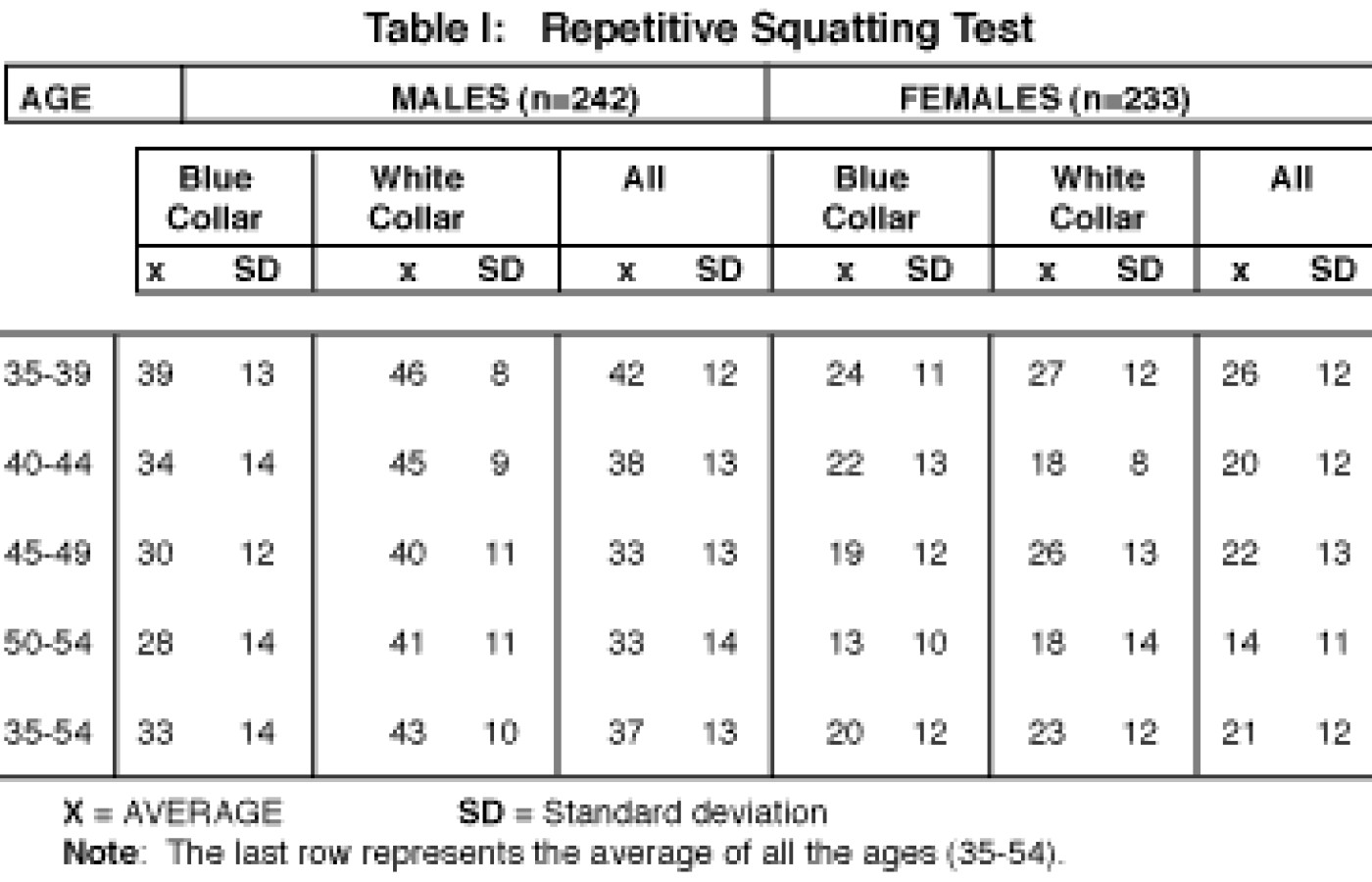In a landmark development, Blue Cross Blue Shield (BCBS) has reached a $2.8 billion settlement to resolve antitrust claims brought by health care providers, including chiropractors. The lawsuit accused BCBS of dividing the nation into exclusive regions and limiting competition, which resulted in lower reimbursements for providers. Although BCBS denies any wrongdoing, the company agreed to the settlement to avoid lengthy litigation – and you can get a piece of the pie.
Documentation of Physical Capacity: It's Purpose in Rehabilitation
[Editor's note: This page contains several tables and graphs; please allow for additional downloading time.]
The Rationale for Physical Capacity Tests
Patients need clear goals to change behavior. Workers' compensation case managers also want to see a clearly expressed goal of care. Alongside identification of activity intolerances from functional questionnaires (e.g. Oswestry), examination of physical capacity deficits provides objective, quantifiable data from which realistic end points or goals of care can be established.
A major reason why more chiropractors don't prescribe more exercises for their patients is that it is hard to motivate the patient. One way to overcome this obstacle is to perform a small battery of quantifiable physical capacity tests to identify the patient's "weak link." If a patient is less than 85% of normal for any specific test, then it will be obvious to both the chiropractor and the patient that some training is required. Ironically, it is the chiropractor's perception that patients are poorly motivated that leads to poor patient compliance as much as anything else. The tests shown here are an excellent way to show yourself that a patient's persistent or recurrent pain or dysfunction may be due to factors in the patient's not the doctor's control. These tests provide unmistakable evidence to persuade the patient of the potential value of performing certain simple exercises.
In the 1980s, Tom Mayer demonstrated that by measuring low back dysfunction, or the deconditioning syndrome, an objective basis for treatment of chronic disability could be established.1 Unfortunately, many measurable forms of testing involve very expensive "high-tech" types of tests. Are these really necessary? Newton and Waddell showed that "low-tech" tests are as reliable and surprisingly even more valid in that they correlated better with other measures of disability.2 Alaranta et al. recognized that expensive functional testing was impractical for the average occupational musculoskeletal health care professional.3 He showed that a battery of tests could be used which are safe, inexpensive, time efficient, reliable, and comparable to normative databases. One of the original tests, Sorensen's static trunk extensor endurance, has been shown to predict recurrence rates in recovering patients and first time onset of low back pain in asymptomatic individuals.4,5
When to Perform Physical Capacity Tests - The Indications
When should a physical capacity evaluation be performed? As soon as the patient is out of the acute pain phase. In fact, this is when the goal of care transitions from pain relief to functional restoration and these tests are important for establishing such goals clearly.
How to Perform Physical Capacity Tests - The Craft
Most of these tests are shown in my video or in the excellent new chiropractic text: Outcomes Management by Steven Yeomans.6,7
1. Repetitive Squat3
Patient position: The patient stands with feet shoulder-width apart.
Technique: The patient squats until thighs are horizontal and returns to upright position. Each repetition rate is 1/2-3 seconds. Repeat to maximum.
Observe: Count number of repetitions (max. 50).
The normative data for dynamic squatting endurance is segregated by age, sex and occupation are in the table below.3
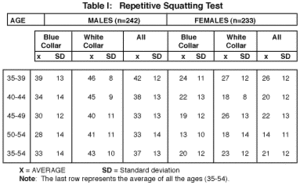
2. Repetitive Sit-up3
Patient position: The patient is supine, knees flexed 90 and ankles fixed.
Technique: Patient sits up until touching the thenar-hand to patella, and curls back down to the supine position.
Observe: Count number of repetitions (max. 50).
The normative data for dynamic trunk flexor endurance segregated by age, sex and occupation are in table below.3
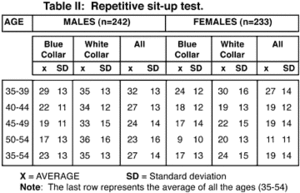
3. Static Back Endurance Test3
Dr. Position: The doctor is at the side of the table holding the patient's ankles (strap is ideal). Alternatively, a Roman chair type of device can be used.
Patient position: The patient is prone with the inguinal region at the end of the table; arms at sides, ankles fixed and holding horizontal position.
Technique: The patient maintains the horizontal position as long as possible.
Observe: Time the duration the position can be held (max. 240 seconds).
Normals:
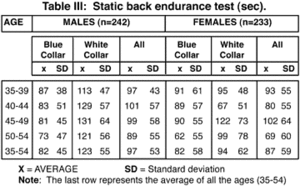
4. One Leg Stand Normative Data8-11
Dr. Position: The doctor is near the patient.
Patient position: The patient is standing on one leg; nonsupport leg is bent 60 degrees at the hip and 90 degrees at the knee so that the ankle is at the height of the support leg's knee.
Technique: The patient maintains the position as long as possible.
Observe: Time the duration the position can be held, i.e., until the patient moves the support foot, puts other foot down, or reaches out to grasp with the hand(s).
Normative data:
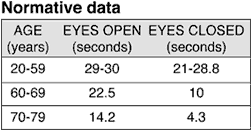
5. Horizontal Side Bridge Endurance12
Dr. Position: The doctor is near the patient.
Patient position: The patient is side lying, supported on forearm and crossed ankles.
Technique: The patient raises up on forearm and ankles until pelvis and trunk are nearly horizontal.
Observe: Time the duration the position can be held until the patient's pelvis returns to the floor.
Normative data
In this study, data was only gathered on young healthy subjects, 75 (31 men, 44 women).
Even though this study did not cover a broad range of different age groups, the ratios between side bridge and flexor or extensor tests are of most interest. Men could sustain the "side bridge" for 65 percent of the extensor time and 99 percent of the flexion time; the women could sustain the "side bridge" for only 39 percent of the extensor time and 79 percent of the flexion time. The tests proved to be reliable, with reliability coefficients of > 0.97 for the repeated tests on five consecutive days and again eight weeks later.
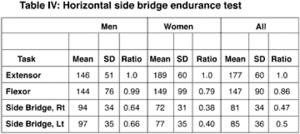
Conclusion
Quantitative physical capacity performance tests are ideal for establishing clear goals in cases involving chronic patients. They provide invaluable documentation of progress under care that can help motivate patients that they are on the "right track." Patient's who are difficult to motivate to perform exercises are ideal candidates for quantifiable functional testing. Such testing provides the clear feedback that is needed to motivate patients and facilitate better compliance or program adherence.
Workers' compensation case managers are often reluctant to approve ongoing chiropractic care. If rehabilitation is being recommended, clear objective goals must be established to demonstrate to third-party payers the validity of the approach.
References
- Mayer T, Gatchel R, Kishino N, et al: Objective assessment of spine function following industrial injury: A prospective study with comparison group and one-year follow-up. Spine 1985;10:482-493.
- Newton M, Waddell G. Trunk strength testing with iso-machines, Part 1: review of a decade of scientific evidence. Spine 1993;18:801-811.
- Alaranta H, Hurri H, Heliovaara M, et al. Non-dynamometric trunk performance tests: Reliability and normative data. Scand J Rehab Med 1994; 26:211-215.
- Biering-Sorensen F: Physical measurements as risk indicators for low-back trouble over a one-year period. Spine 1984;9:106-119.
- Luuto S, Heliovaara M, Hurri H, Alaranta H. Static back endurance and the risk of low-back pain. Clin Biomech 1995;10:323-324.
- Yeomans S. Outcomes Management. Appleton & Lange, Stamford, Connecticut, 1999.
- Liebenson C, Chapman S. Rehabilitation of the Spine: Functional Evaluation of the Lumbar Spine - videotape, Williams & Wilkins, Baltimore, 1998.
- Bly N. Spatial orientation to gravity and implication for balance training. Orthopaedic Physical Therapy Clinics of North America. 1:2, October 1992. PP207-236.
- Atwater SW, Crowe TR, Deitz JC, et al. Interrater and test retest reliability of two pediatric balance tests. Phys Ther 1990; 20:79-87.
- Bohannon RW, Larkin PA, Cook AC, et al. Decrease in timed balance test scores with aging. Phys Ther 1984; 64:1067-1075.
- Chandler JM, Duncan PW, Studenski SA. Balance performance on the postural stress test: Comparison of young adults, healthy elderly and fallers. Phys Ther 1990; 70:410-415.
- McGill SM, Childs A, Liebenson C. Endurance times for stabilization exercises: clinical targets for testing and training from a normal database. Arch Phys Med Rehabil 1999; 80: submitted for publication.
